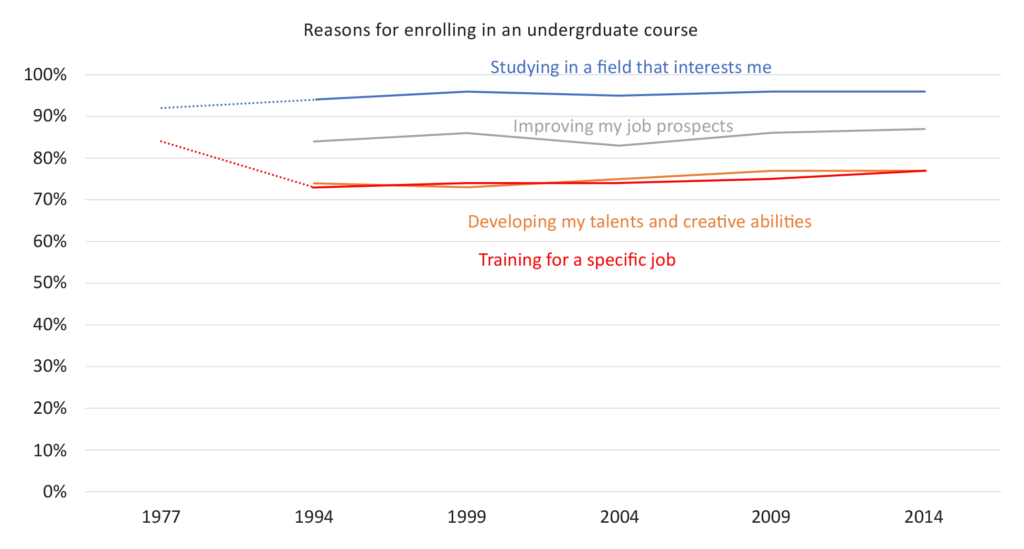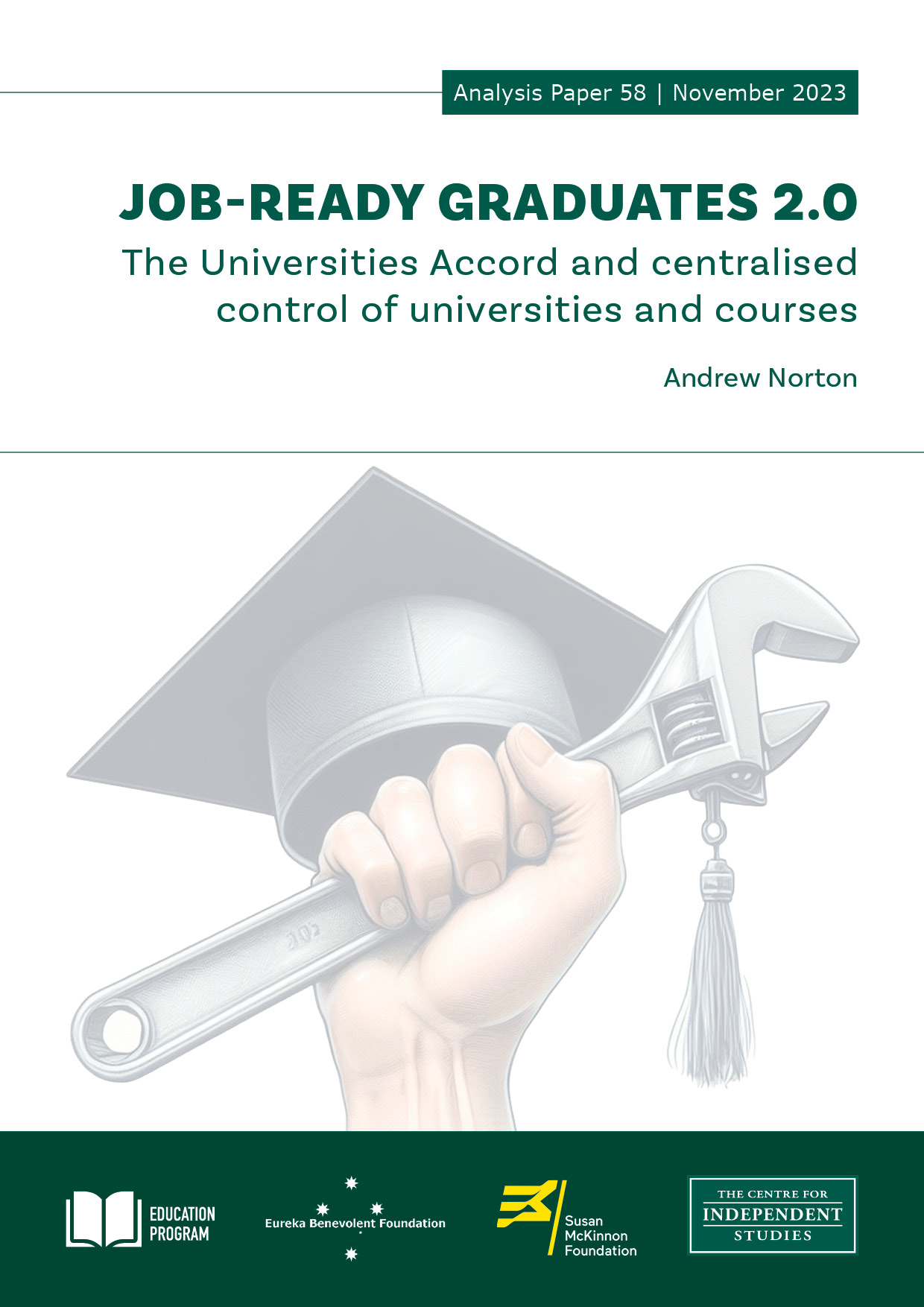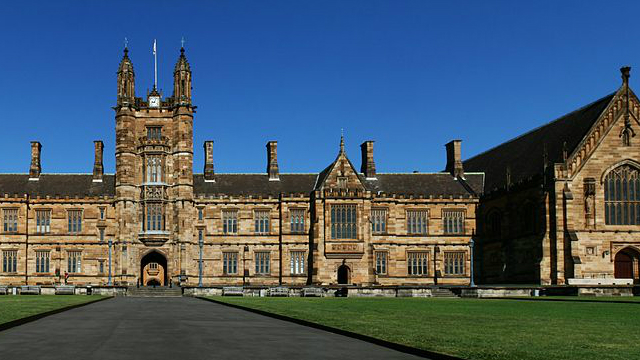
Summary
Australia’s graduate labour market does not always seem to function well. Graduates with degrees in some fields struggle to find suitable work, while employers cannot fill vacancies in occupations that rely on graduates.
The former Morrison and current Albanese governments share an interest in these problems, but with contrasting policy responses.
To steer student choices, the Morrison government’s Job-ready Graduates policy discounted student charges for preferred courses and doubled them for courses deemed less ‘job ready’. But it did not intervene in university supply decisions, instead giving universities more flexibility in moving public funding between courses. It was a demand-side intervention.
The Albanese government’s Australian Universities Accord review aims to replace Job-ready Graduates with supply-side interventions, increasing or decreasing numbers of student places in different courses according to perceived needs.
The Universities Accord interim report is vague on important details. But its authors clearly want to replace current decentralised modes of decision-making, under which universities and students coordinate the allocation of student places to courses, with a more centralised and bureaucratic system of control.
A new regulator, the Tertiary Education Commission (TEC), would be responsible for increases or decreases in student places by courses at each university. It would be guided in these decisions by Jobs and Skills Australia, a government labour market analytics agency.
Detailed TEC control of enrolments would overturn longstanding practices of allocating most public university funding in a flexible way. Historically, block grants are the most common funding method. In this system, universities decide which courses to fund within a capped overall amount. Under a less common system, demand driven funding, university decisions are not constrained by a funding cap.
However, no system of allocating funding to universities can abolish apparent mismatches between degrees and jobs. Not all university students enrol for employment reasons, and the options of those that do are constrained by their academic abilities and their interests. Few people will commit to a course or career that does not interest them.
The labour market can change more quickly than the flow of graduates from three-year degrees. The number of professional jobs in skills shortage has almost tripled since 2021. The 2010s graduate boom times predicted by a previous higher education review were instead the worst ever period for new graduates looking for work.
Perfect alignment between graduates and jobs is impossible, but we can design systems to adapt quickly to emerging employment opportunities and risks.
The centralised approach preferred by the Universities Accord interim report is unlikely to outperform the more flexible block grant or demand driven systems. Its decision making would be on a bureaucratic cycle, responding more slowly than universities observing changes in student applications. Bureaucratic systems could lock public funding into yesterday’s labour market needs, causing stranded resources that cannot be used effectively.
Australia’s one long-term experience of bureaucratic allocation of student places, for medical courses, is not encouraging. Australia relies on doctors from overseas and has many doctor job vacancies.
The Universities Accord final report goes to the government in December. It should drop its plan for more university bureaucracy. Decentralised decision-making by universities and students is a lower-risk way of achieving its labour market goals.
Introduction
Australia’s policymakers are famously utilitarian, concerned more with delivering practical benefits than pursuing other kinds of value.[1] This political culture creates tensions between governments and universities. Governments want skilled graduates and research to advance national development. Australian universities share these aims but want autonomy to pursue other goals, including knowledge for its own sake.[2]
Historically these tensions reflected differences of emphasis and not fundamental conflicts. University autonomy was built into university founding legislation, which made them independent of government. Policy interventions to steer student enrolments were mostly soft touch. Some government-subsidised student places were earmarked for specific courses. Students were offered financial incentives to take courses leading to priority occupations. But universities decided which courses to offer and how to distribute students between them. Universities typically moved enrolments in the same direction as the labour market. They also maintained significant faculties of arts and science, reflecting the broad intellectual interests of universities and their students, but whose graduates sometimes struggled to find appropriate work.
More recent governments, however, are pursuing wide-ranging steering of enrolments to courses they prefer.
In 2021, the Morrison government implemented its Job-ready Graduates policy, the most explicitly utilitarian higher education program to date. Its name clearly signals the policy intent. It aims to “incentivise students and universities to focus on work relevant qualifications”.[3] The incentive is financial; through the student contributions domestic students pay in government-subsidised student places. Student contributions in courses the government deems ‘job ready’, likely to help meet skills needs, are discounted. As a deterrent, students in other courses incur higher student contributions — more than doubling in the case of most humanities subjects.
The Albanese government is almost certain, eventually, to overturn the Job-ready Graduates pricing system. But Job-ready Graduates will go, not because its labour market focus is excessive, but because its chosen policy mechanism is ineffective and burdens students with unnecessary debt. Albanese government higher education policies announced to date, along with the interim report of a major policy review it commissioned, the Australian Universities Accord, suggest more interventionist policies to achieve job-market goals. These include a new agency to match student funding to predicted labour market needs. The University Accord offers Job-ready Graduates 2.0.
The issues here are partly philosophical, about the purposes of higher education and the relationship between governments and universities. This CIS report’s primary focus, however, is on the practical —about which policies can most effectively coordinate the supply of student places with two demand forces, those of students for courses and employers for graduates. It compares bureaucratic models where the government coordinates the system, as proposed by the Accord interim report, with decentralised models, in which local-level decision-making determines the distribution of student places between courses.
Different models of allocating student funding to universities
Public funding policies for student places need to make key decisions: about overall total funding, and then how these resources are allocated at the university, course or discipline, and student levels. Table 1 describes four broad systems according to who makes these decisions.
Bureaucratic and demand driven systems sit at either end of the decision-making spectrum, respectively all decisions centralised in government and all decisions decentralised to students and universities. With block funding the government decides overall and university-level funding —capping its overall expenditure — but decentralises decisions below that. ‘Voucher’ funding systems allocate funding to students, who then decide where to take it. A voucher system lets the government control who receives funding and impose conditions on its use. Voucher systems combine elements of the bureaucratic and demand driven models.
Table 1: Models of allocating higher education public funding

Note: Practice varies in whether funding is expressed in student places or a sum of money.
Across a higher education system these models are not mutually exclusive. Versions of the block, demand driven and bureaucratic models currently operate. Only the voucher system is unused.
Block grants, sums of money allocated for broad purposes without specifying their use in detail, are the largest source of public funding now and in most stages of Australian higher education policy history. Australia’s 38 publicly-funded universities share in $6.7 billion allocated for 2023 through the current teaching block grant.[4] About three-quarters of domestic students are funded through this block grant.[5]
The most important block grant constraint is a maximum annual grant payment for each university. Within that maximum amount, universities distribute their public funding between non-research courses other than in medicine. As universities self-accredit their courses, they can devise new courses or revise existing courses without government approval.[6]
On top of grant funding universities receive student contributions, a price capped charge for students in government-subsidised places. The price caps range from $4,124 a year for favoured courses such as nursing and teaching to $15,142 a year for disfavoured courses such as arts. Universities can charge less than these amounts but usually charge the maximum.[7] Job-ready Graduates 1.0 tries to guide student choices using these price caps as demand-side influences; with small possible influences on enrolment patterns detected with the limited data currently available.[8]
Student contribution revenue has no annual maximum amount per university. This means that the system has soft caps — a university may lose money by taking students not funded by the block grant, but no other penalty applies. Student contribution revenue is not publicly matched to the grant funding schemes, but in total public universities will earn approximately $5.4 billion from student contributions in 2023. In cash flow terms, more than 90 per cent of this amount will come from government though HECS-HELP student loans. On current estimates, students will eventually repay about 85 per cent of the money they borrowed.[9]
For a period in the 2010s, the government lifted public funding caps on domestic bachelor degree students, creating a ‘demand driven system’, with medicine again the only course excluded. This triggered a phase of rapid enrolment growth, lifting the proportion of young Australians enrolled in higher education at age 19 from 30 per cent in 2007 to 40 per cent in 2016.[10] The demand driven system ended in 2017 for budgetary reasons. A small demand driven grant system was reintroduced in 2021 for Indigenous bachelor-degree students from regional areas, supporting around 7000 students at a cost of $47 million in 2023.[11] This will be extended to metropolitan Indigenous students in 2024. [12]
Australia’s one long-term bureaucratic intervention in higher education student places is medical courses. Universities are allocated specific numbers of places, with grant funding of just over $400 million.[13] As of 2021, Australian universities enrolled 15,000 domestic medical students. Universities can be penalised if medical enrolments vary “in ways that will change the number of domestic annual completions for the course or courses”.[14] No other course has an equivalent provision. As described in more detail in a subsequent section, this hard cap reflects concerns about doctor over-supply.
Less strict specific allocations of student places have applied at different times, especially for postgraduate nursing and teaching, and for distributing new student places, which have often been earmarked for specific courses.
Since the 1980s, public universities have also offered market-driven places — with no restrictions on fees or student numbers — to international students and domestic postgraduates. Four private universities and more than 150 non-university higher education providers operate largely outside the public funding system. Their domestic students are, however, usually eligible for FEE-HELP loans, a HECS-HELP equivalent for students in unsubsidised student places.[15] International and domestic students in market-driven student places made up 40 per cent of all enrolments in 2021.
Graduate employment
The primary concerns about graduates and the labour market fluctuate with the economic cycle. When business conditions are good, the focus is on skills shortages. In 2008, when the policy review that led to the demand driven system was underway, 37 professional occupations of the type normally held by graduates were in skills shortage, as based on surveys of employers who had recently placed job advertisements. That was the highest number recorded in a time series that began in 1986.[16] In 2023, the year of the Universities Accord review, a record 157 professional occupations were classed as in skills shortages, almost triple the number in 2021. Shortages of health, ICT and engineering professionals were most common.[17]
When business conditions are flat or declining, the main graduate employment concern is poor outcomes for recent graduates. The global financial crisis of the late 2000s and the end of the mining boom in the early 2010s both affected employment rates for new graduates. In 2014, 32 per cent of new bachelor graduates looking for full-time work had not found it about four months after completing their course, the worst result of the 1982-2022 period. In the overall labour market, only five professional occupations were in skills shortage. Several studies showed that median early career graduate earnings fell in the 2010s before later recovering. People with degrees linked to occupations find it easier to get work than people with degrees in science, arts, or creative arts.[18]
Policy reviews and politicians have expressed concerns about too few or too many graduates of varying degrees. But even the policy most explicitly about employment, Job-ready Graduates 1.0, did not try to force universities and their students into a government plan for graduate labour supply. Instead, it offered students financial incentives to take or not take courses, impliedly assuming that universities would change enrolments in line with student demand. It also quarantined some money previously in a general block grant for industry-related activities such as work-integrated learning.[19]
A new era of government intervention?
The July interim report of the Universities Accord review suggests that it wants government to take a far more active role in higher education, moving it from decentralised to centralised decision making. The interim report includes 25 policy ideas that would, or could, reduce the scope of university decision making.[20] This CIS report will focus on their ideas for steering enrolments towards government-preferred courses, the types of students to be prioritised, and the student admission system. The Accord interim report’s interventionist agenda is, however, more wide-ranging than these issues. It includes more control of the overall mission of the institution, Indigenous ‘self-determination’ within the university, how to spend both public and private money, how courses are taught, and regulation of the overall student experience.
The Universities Accord report is, as noted, an interim one. Except for five recommended ‘priority actions’ already endorsed by the government, its policy agenda is not fixed. Most proposals are presented briefly, often without clarity and never with implementation details. Other ideas mentioned — for example, several references to ‘flexibility’ and student choice — are in tension with an otherwise prescriptive set of policy suggestions. The final report, due to go to the government in December 2023, will presumably provide extra detail and, perhaps, a less radical policy direction.
While the Accord review team may change direction by December, its interventionist agenda aligns with the government’s higher education policies since coming to office in 2022.
Despite the current overall policy design of a block grant, the government prefers allocating additional student funding with detailed conditions.
In the 2022 federal election, Labor promised 20,000 additional student places from 2023. The allocation criteria are detailed: the government specifies by university the courses to receive the places, those in areas of skills shortage; and the type of students who can receive them, people from ‘equity groups’. The process had university input through an initial application process, but universities were then allocated places in courses they had not nominated.[21] In theory, universities can decline these allocations. The legal mechanism for distributing the additional places is a funding agreement between the Commonwealth and each university, which both parties must sign. But universities rely on these agreements for a large proportion of their revenue. Their bargaining position is weak.
In August 2023, the government released its criteria for awarding student places to support its nuclear submarine program. As with the earlier 20,000 places policy, the government called for applications, with South Australian universities given a protected share. Unsurprisingly, courses eligible for funding must relate to the nuclear submarine program.[22]
Compared to the 20,000 places allocation, the submarine places policy makes greater use of ‘selection criteria’ that effectively add significant new conditions. Applicant universities need to provide strategies and timelines for how additional funding will enhance teaching and maximise student success. Applicants also need to outline existing and any further steps they will take to attract, retain, and support equity students. It reflects a low-trust, high-regulation approach to funding higher education with strong parallels to the Universities Accord interim report.
Models for allocating funding and the Universities Accord interim report
This section explains the interim report’s ideas for allocating funding. As what its authors intend is sometimes unclear, inference from the report’s overall goals is mixed with direct textual evidence to outline the possibilities.
Removing or substantially increasing caps on student places is necessary to achieve the interim report’s higher education participation and attainment targets. In 2022, the bachelor degree or above attainment rate was around 40 per cent for Australian citizens aged between 25 and 34 years.[23] By 2050, the report says that 55 per cent of Australians should be educated to this level.[24]
An ambitious attainment goal points towards demand driven funding. As seen in Table 1, this model dispenses with enrolment and funding caps. The interim report suggests a ‘universal learning entitlement’ to support higher and further education. An ‘entitlement’ implies that everyone meeting a threshold of need or capacity to benefit should receive financial assistance for higher education, without pre-determined annual caps on the total.[25]
More explicitly, the interim report recommended extending demand driven funding from regional Indigenous students to all Indigenous students.[26] As noted earlier, this will happen from 2024 after the necessary legislation was approved by Parliament in October 2023. The Accord final report is expected to favour extending demand driven funding to other equity groups, such as students from regional areas or with a low socioeconomic status background.[27]
While demand driven funding is often seen through a participation prism, as the interim report does in recommending it for equity groups, it is also a decentralised way of allocating resources between courses and universities. Higher education providers decide what courses to offer and how many student places to provide, while prospective students decide which of these courses, if any, to apply for and enrol in if offered a place.
In the interim report’s perspective, these features are faults of demand driven funding, which “focuses only on the willingness of a student to learn, and the willingness of a provider to enrol”.[28] Demand driven funding supports, the interim report says, choices that do not necessarily “meet the societal and economic needs of their region and the nation”. It cites growth in science and arts enrolments under the previous demand driven system that led to poor employment outcomes.[29]
Impliedly, this is also a criticism of block grant systems, which also let enrolments move towards courses students want to take, rather than the courses the government thinks they should take.
The interim report recognises limits in the potential applicant pool, that “willingness to learn” cannot be ignored. It refers to students pursuing “courses that align with their abilities and interests”. But it qualifies this acknowledgment by saying that this should be “within a system that takes account of the national interest in the overall supply of a highly talented, highly skilled, well-located workforce, which meet the changing needs of the economy”. [30] The interim report briefly outlines how this could be done.
Jobs and Skills Australia (JSA), a government labour market analytical agency, would identify needed skills and qualifications. It already publishes reports on recent skills shortages, used in the earlier discussion of graduate outcomes, and projected demand for different occupations. The JSA does not link skills demands to higher education enrolments or course completions but may do so in the future.[31] A proposed Tertiary Education Commission (TEC) would translate JSA advice into “necessary action” by the higher education sector.[32]
The JSA-TEC model of the interim report would reduce the role of students and universities in deciding how enrolments are distributed between courses. It is a technocratic version of the bureaucratic model, characterised by experts planning the supply of student places based on expected labour force needs. Courses with relatively poor employment outcomes would not necessarily be closed, but student numbers could be limited. The UK government has announced a similar policy restricting ‘low-value’ degrees in English universities.[33]
Exactly how a TEC would implement these decisions is unclear. When the interim report directly discusses a TEC it envisages control over universities. The TEC’s roles would include “determining funding allocations” for universities and negotiating agreements with them “to deliver against local, regional and national priorities and needs”.[34] But in student-driven funding models, universal learning entitlement or demand driven systems, the government does not directly allocate funding to universities.
This tension between student entitlements and TEC control through institutions is not resolved within the interim report. But a voucher model, as outlined in Table 1, could reconcile the two policy objectives. The TEC could restrict use of universal learning entitlements by allocating funding between courses or fields of education. Courses with current, or expected, labour market needs would receive additional vouchers, while courses with actual or anticipated poor employment outcomes would receive fewer vouchers.
A voucher model designed to implement TEC plans could give students less choice of course than previously, but more choice of institution. A possible Accord final step is ensuring that supply more reliably meets voucher-driven demand. As detailed later, university offers typically respond to movements in course applications, so further controls may be unnecessary. But the Accord interim report shows low trust in universities. It worries about the “willingness of a provider to enrol”. To increase the conversion of TEC voucher allocations into enrolments, universities may have less scope to reject applicants.
If so, the TEC voucher model would need to manage funding and admissions. Under the current system, the government does not directly allocate funding to students. Effectively, universities are delegated decision makers on funding within general rules the government sets. The interim report already suggests a “consistent national approach” to tertiary education admissions.[35] The stated goal is simplifying entry into higher education, but a national admissions system could also process course funding applications. As with current state-based university admissions centres, a preference system could be used. Applicants who miss out on their first preference field or course type would be eligible for a voucher matched to a second or lower preference field.
Problems with centralised systems
Questions remain, though, over whether a centralised model of allocating student funding outperforms its more decentralised alternatives in improving graduate labour market outcomes. Three issues, described in the following sections, will prove hard to overcome. These are the difficulty of predicting future graduate labour market needs, the limits of student willingness to do the preferred courses, and the risk of public resources going unused due to weak student demand. A subsequent section looks at real-world examples of how well different systems have worked since 2010.
Predicting future graduate needs
The JSA publishes interesting reports on Australia’s labour market. It integrates multiple data sources to produce an overall picture of its current state and possible future. As noted earlier, JSA’s workplan includes greater integration of higher education data. This would fill a significant gap. No general projections of university course completions exist. Just seven of the hundreds of occupations served by higher education — five health-related, teaching training and aviation — have related enrolments and completions reported in higher education statistics.[36] Other occupational pipelines are buried in fields of education enrolments that include courses related to many different jobs.
The JSA’s work is valuable but labour market predictions often turn out to be wrong. The 2008 Bradley higher education policy review, which led to the demand driven system, commissioned labour market projections. These predicted that demand for people with undergraduate qualifications would exceed supply during the 2010s.[37] With many professional occupations in skills shortage at the time, this was a plausible extrapolation forward of recent trends. But as we now know, graduate employment rates and income fell in the 2010s.
Cyclical and structural changes in the economy, along with major shocks like COVID-19, will continue to produce hard-to-predict results. Shortly after Australia went into the first COVID-19 lockdown, unemployment was forecast to reach between 10 and 15 per cent.[38] It peaked at 7 per cent before falling to a 50-year low, accompanied by record numbers of professional occupations experiencing worker shortages.
The Universities Accord interim report includes an economic consultancy’s forecast that 55 per cent of the workforce will require a degree by 2050.[39] The JSA plausibly predicts medium term increases in some occupations requiring degrees, due to ‘megatrends’ boosting health and social care occupations and the large, highly-skilled workforce needed for a transition to clean energy. Another megatrend, artificial intelligence, is less benign for future graduate employment.[40] AI will generate new roles for university-educated workers but could also automate tasks carried out by graduates across many occupations. Such uncertainties make the year 2050 too far away for planning. We can’t know now what education people yet to be born will need for jobs yet to be invented.
The fallibility of forecasts is not an argument against the JSA’s work. Its analysis can inform higher education decisions regardless of funding system. Block and demand driven systems incorporate supply and demand factors through the revealed preferences of universities and prospective students. Employment and income information influence student course choices, as subsequent sections show. JSA analysis can add to this employment information flow.
But making the JSA the only or principal source of data for TEC student place allocations involves risks. It focuses on employer demand for workers, not the opportunities or constraints of the prospective student pool. The TEC could calculate the likely number of ATAR-track school leavers, but less easily predict their post-school plans.
Demand constraints
Student abilities and interests limit how well any higher education funding model can respond to skills shortages. School student aspirations for higher education are high, but academic results limit the pool of applicants.[41] In some states less than half of Year 12 students are on an ATAR track, taking subjects that prepare them for higher education.[42] Many courses leading to in-demand occupations — including health, engineering, IT and teaching — require or recommend Year 12 maths.[43] Yet Year 12 advanced maths enrolments are slightly down and intermediate mathematics significantly down.[44] NAPLAN results do not suggest that more academically able student cohorts are moving through the school system.[45]
Student interests also constrain course choices. ‘Interests’ here means preferences for particular topics and activities rather than financial considerations. People can have multiple interests and change interests, but generally interests are stable aspects of personality that predict course and job choices.[46]
As Figure 1 shows, students asked about which motivations were important in their decision to enrol consistently nominate ‘studying in a field that interests me’ more often than any other reason. Over 90 per cent of respondents rate interest in their field as important.[47] This response option highlights that intrinsic interest in a field and apparently extrinsic goals like training for a specific job are not necessarily distinct. Intrinsic interest is a constraint on system steering, as few people pursue courses and careers which do not engage or suit them.
Figure 1: Student motivations for enrolling in an undergraduate course

Sources C. Baik et al. The first year experience in Australian universities: findings from two decades 1994-2014; Survey conducted for the 1977 Williams report on education and training (data available from the ANU Australian Data Archive). The Williams survey did not ask about general job prospects.
The constraint of interests does not prevent changes in demand for specific courses. Applications data shows that although total demand increased in the 2010s specific fields fluctuate year-to-year.[48] While many field of education application shares show long-term stability others have changed significantly (Figure 2).
Figure 2: Changes in university application share by field of education, 2010-2021

Source: Department of Education, Undergraduate Applications, Offers and Acceptances, 2010-2021
The theory of interests suggests that prospective student course choices are most swayable within their cluster of interests. Figure 3 uses applications data to identify these clusters. When applying through tertiary admissions centres, university applicants can list multiple courses in order of preference. As Figure 3 shows most second or lower preferences are for another course in the same field as the first preference, but clusters of cross-preferencing are also visible — between commerce, law and humanities; between a range of science-related courses, and also between health-related courses.[49]
Figure 3: Preference clusters by field of education (2014 and 2015 applications)

Source: Grattan Institute analysis based on Department of Education data.
Stranded resources
Bureaucratic models lock resources into predetermined uses. From a government perspective, this can desirably limit expenditure on wasteful or lower priority activities. But without a mechanism for reallocating resources a bureaucratic model risks, as circumstances change, funding allocations supporting past rather than present or future needs. A TEC-like institution can minimise inertia by regularly reviewing how resources are used and reallocating them when needed. Using expert advice in this task converts the system from being just bureaucratic to being technocratic.
In the TEC technocratic model, student demand by course is a constraint rather than the driver of enrolments, as it is for demand driven funding. The Accord interim report’s criteria for distributing student places between courses aim to satisfy employer rather than student preferences. The distinctive supply-side lever in technocratic models is control of student places at the course or field of education level. To steer enrolments, the number of places in specified courses or fields would increase or decrease. The apparent logic of the Accord interim report is for a voucher model, but direct allocation to universities is another possible mechanism. Complementary demand-side interventions such as careers advice, marketing and scholarships could also be used.
The technocratic model could most successfully re-direct demand within clusters of interests. For science, one field the interim report identifies as over-supplied during demand driven funding, applicants also express interest in more vocational fields such as engineering, agriculture and other health, which is mostly allied health courses (science line in Figure 3). For arts, the other field identified as over-supplied by the interim report, applicants also express interest in more vocational fields such as commerce, law, education and other health (humanities line in Figure 3). The theory is that prospective students still wanting a university education will take a second or lower preference course when denied their first preference due to limits on supply.
All restrictions on how student places can be used, however, can leave stranded resources — funding that is theoretically available but in practice cannot be used. Block grant systems, which always limit funding by university and sometimes by other criteria, also have this issue.
Before Job-ready Graduates, most funding came through three qualification-based block grants: sub-bachelor courses (such as diplomas), bachelor courses, and non-research postgraduate courses. In 2018, 25 of the then 37 public universities ‘under-enrolled’ for at least one of these three grants, attracting too few students to earn their maximum grant. Of the 25 universities with an under-enrolled block grant, 22 had at least one ‘over-enrolled’ grant category, leaving them unpaid for students above their maximum grant.[50] Applicants can be rejected because their target university has hit a funding cap, despite unused grant money elsewhere in the institution or at the system level.
Unused resources are not necessarily a problem for a government that tightly targets its expenditure. Money is to be spent on the intended activity or not at all. But when governments have multiple policy objectives, as the current government does with equity group participation and skill shortages, stranded resources are an issue. Every condition added to funding reduces the chance of finding a student who matches all the criteria.
For the current government’s 20,000 places policy, four criteria apply: institution, qualification level, course and student equity group membership. For the goal of meeting skill shortages excluding the 60 per cent of the potential applicant pool who are not equity group members does not help.[51] For the goal of increasing equity group enrolments, restricting places to skills shortage related courses excludes potential equity students with other interests. These constraints reduce the chance that the promised 20,000 additional places will ever eventuate.[52]
Demand driven funding is the model least likely to leave stranded resources. In pure versions, no limits are placed by institution, qualification level, field of education or student type.[53] Block grant institution level funding caps mean that popular universities cannot meet all demand. But with a block grant each university can, within its funding cap, move resources between courses and enrol any domestic student. The current main block grant is flexible on qualification level.
If a voucher model is the ultimate result of the Universities Accord final report then the institution constraint of the 20,000 places policy would be lifted. But longer-term restrictions by course, qualification level or student type would remain an obstacle to participation and attainment targets. These restrictions also make it essential for the JSA to offer good advice about skills needs and for the TEC to implement that advice successfully.
Real-world performance of different models in meeting skill needs
Australia has recent medium to long-term experience of three funding models: demand driven funding (2012-2017), block grants (in varying forms, the main source of teaching funding except 2012-2017) and bureaucratic allocation of medical places, which has been in place for decades. The voucher model has not been used.
Nursing and engineering
Figures 4 and 6 use one indicator of employment opportunities, job advertisements, and compare trends with applications for nursing and engineering courses. These occupations were chosen for their regular appearances on skill shortage lists. The trend lines use an index with 2010 as the base year, to help compare indicators with differences in absolute numbers. Few prospective students would directly monitor JSA’s job advertisement numbers. Advertisement trends should, however, relate to what prospective students see or hear from other information sources, including careers advisers, student advice websites, job sites like SEEK and media reports.
For nursing, in Figure 4, job advertisements and applications generally tracked each other over the 2010 to 2021 period, other than a late 2010s applications plateau. This growth reflects a general shift in applications towards health courses (Figure 2), as a large structural change in the Australian labour market creates jobs in health and social care industries. Nursing courses entry requirements vary between universities, but generally do not require a high ATAR, reducing prerequisite barriers.[54]
As Figure 5 shows, trends in nursing applications typically translate into offers from universities and subsequent enrolments. The sharp spike in nursing applications for the 2021 academic year, possibly reflecting the high-profile of nurses while COVID-19 dominated the news, was met with less marked growth in offers and enrolments. Since the demand driven system ended in 2017 universities face funding constraints in responding to demand. In nursing, along with other health fields, limited clinical training places also restrict expansion independently of higher education policy.
Figure 4: Relationship between job advertisements and applications, nursing

Sources: Department of Education, Undergraduate Applications, Offers and Acceptances, 2010-2021;
JSA, Internet vacancy index
Note: Job advertisement statistics use a 3-month rolling average. The index uses the September number for the year prior to the one shown, to include the period in which school leaver applications decisions are finalised.
Figure 5: Demand for and supply of commencing nursing student places

Sources: Department of Education, Undergraduate Applications, Offers and Acceptances, 2010-2021; Department of Education, Selected Student Statistics.
For engineering the relationship between job advertisements and applications is less clear (Figure 6). Predictable demographic changes reliably increase nursing employment while engineering is a boom-and-bust profession. Employment moves up and down with business cycles in mining and construction. The time series base year captures the final mining boom years. The applications index usually moves in the same direction as job advertisements, but with much smaller percentage changes.
Interests are a likely moderating force. At the margins, employment news attracts or deters some people with engineering-related interests to, or from, engineering courses, but most follow their interests either way. For engineering this is a strength, as too many prospective students following the labour market down would exacerbate skill shortages when boom times return. Less positively, mathematical prerequisites constrain upswings in engineering applications.
Figure 6: Relationship between job advertisements and applications, engineering

Sources: See Figure 4.
As with nursing, for engineering both block grant and demand driven systems delivered supply that largely followed demand (Figure 7). Unlike nursing, commencing enrolments grew more quickly than demand in the later years shown.
Figure 7: Demand for and supply of commencing engineering student places

Sources: As for Figure 5
A bureaucratic system could not easily improve on these results. Supply decisions going through a TEC-like central agency would slow reaction times to movements in student demand. If the TEC’s allocation mechanism was something like today’s funding agreements, used for the 20,000 and submarine places policies described above, months would pass between recognising the issue and signing new funding agreements.[55] In a voucher model, which seems most consistent with the Accord interim report overall approach, the balance of vouchers between courses may need to change. Voucher rounds are likely to occur on set schedules, with prior application periods, again slowing response times.
In some fields, the TEC blocking the supply of alternative courses could shift enrolments towards a more preferred pattern, but with nursing this would not work well. Most courses with nursing as a second preference are other health courses also prone to skill shortages (Figure 3). Pushing more places into the system in anticipation of future needs for engineering graduates when demand was soft from the mid-2010s would have led to stranded resources.
Medical courses
Australia’s one long-term bureaucratic intervention in higher education student places is medical courses. Universities are allocated specific numbers of places. Universities face penalties for enrolment changes that would increase the annual number of medical graduates.
Whether medical course allocations are technocratic or just unusually bureaucratic is open to argument. Detailed reports track medical enrolments and the medical workforce, with considerable expert input.[56] Although these reports read like technocratic documents their authors do not believe they have achieved expert control. The complexities of coordinating the many public and private sector practices and hospitals needed for clinical training, messy moves into specialist medical fields by early career doctors, and geographic imbalances in the medical workforce all create problems. The latest health workforce report recommends a new planning and advisory body.[57]
Higher education policy alone, then, cannot be solely blamed for medical workforce issues. But too few Australian medical graduates has left Australia heavily reliant on doctors from other countries. In 2021 a third of medical practitioners held overseas qualifications. In health professions without capped enrolments, the overseas-qualified share is lower — a quarter of dentists and 10 to 15 per cent of most allied health professionals.[58] Despite the large foreign workforce, in 2023 generalist medical practitioners appeared in the top 20 most demanded occupations, based on job advertisements, in every state and territory.[59]
Supply-side rather than demand-side limits restrict medical student numbers. Over half of commencing medical students are in postgraduate courses, making the exclusively undergraduate national applications data a partial count of total demand for medical degrees.[60] Figure 8, nevertheless, shows applications for undergraduate medical courses alone significantly exceeds total commencing enrolments, undergraduate and postgraduate.
Figure 8: Applications, offers and commencing enrolments for medical courses

Sources: Department of Education, Undergraduate Applications, Offers and Acceptances, 2010-2021; Department of Education, Selected Student Statistics, table 8.6.
Note: The applications and offers time series is affected by transitions of medical courses from undergraduate to postgraduate.
Graduate over-supply
Bureaucratic intervention in medicine does, however, demonstrate this model’s effectiveness for keeping enrolments below what a block grant or demand driven system would deliver. As noted above, the Accord interim report singles out arts and science for their poor employment results under demand driven funding. Science and arts graduates do better now than in the 2010s, but still experience relatively low rates of finding full-time work soon after course completion and professional employment early in their careers.[61] Under the Accord interim report approach, these courses are candidates for reduced student places in the ‘national interest’ of balancing student choice with economic needs. Enrolment restrictions would reduce student numbers more effectively than the Job-ready Graduates 1.0 student contribution increases, which caused only small drops in demand and enrolments.[62]
Whether science and arts enrolments should be forcibly reduced cannot be decided using labour market outcomes alone. Employment is not the only reason for taking these courses. Survey evidence suggests significant support from the Australian public for universities serving multiple purposes. In a 2023 poll, the proposition ‘train young Australians for the future workforce’ received the highest endorsement as a university responsibility, but developing new ideas, providing a place for controversial ideas to be debated, and investigating the fundamental questions of the time were all rated as definite university responsibilities by a third or more of survey respondents.[63]
Conclusion – robust systems of meeting labour market demand
Regardless of what happens to science and arts, Australia’s higher education system must contribute to workforce needs. But no system can perfectly align graduates with employment. Student interests are broader than employer needs. Labour markets often change more quickly than the flow of graduates from three-year degrees, as they have since 2021. Labour force supply is not only driven by how many people graduate from Australian universities in the needed fields. Migration to and from Australia, whether graduates are employed in the occupation they trained for, and how many hours they work each year all affect the labour market’s capacity to meet skill needs.
Within these limits we have system choices. We could continue with the current block grant model, return to full demand driven funding, or take the technocratic approach favoured by the Accord interim report.
Decentralised models and a well-functioning technocratic system would deliver similar medium term enrolment trends towards courses in labour market demand. Similar labour market signals would drive all models, but technocratic systems more slowly, due to time lags in re-adjusting institutional or voucher allocations. Delays and mistaken allocations would create stranded resources, funding locked into purposes that cannot be fulfilled due to the demand constraints of prospective student abilities and interests, while other needs go unmet. But technocratic systems could achieve higher overall graduate employment rates, by reducing enrolments in courses with relatively weak graduate outcomes. This would be controversial — universities, prospective students and a substantial proportion of the public want these courses to be taught.
Technocratic models rely heavily on the agency charged with distributing resources. Like any other government agency, the TEC would not be guaranteed a sufficient budget and may have trouble finding suitable staff. The Tertiary Education Quality and Standards Agency, the quality regulator in higher education, has suffered from difficulty recruiting suitably qualified employees and high staff attrition.[64] Universities can also face staffing issues, but in a decentralised decision-making system these are local rather than national problems.
At the time of writing, in early November 2023, Department of Education IT problems mean that the latest published applications and enrolment data is from 2021. If a TEC had been in place, its staff would have been flying blind for close to two years. Universities have IT problems as well, but not all experience computer dysfunction at the same time. Using their own applications and enrolments data, universities can adjust their own course and student place decisions in light of student demand.
The technocratic model of the Universities Accord interim report risks just being a bureaucratic one, which cannot keep up with the changing world that it predicts. Paradoxically Job-ready Graduates 2.0 could be less effective than its Morrison government predecessor, which lets enrolments flow where labour-market informed demand leads it, albeit at high cost to some students.
Related Works
Degree Inflation: undermining the value of higher education. Steven Schwartz. CIS Analysis Paper 48. May 18, 2023. https://www.cis.org.au/publication/degree-inflation-undermining-the-value-of-higher-education/
ATAR’s Rising Relevance: admission standards and completion rates. Rob Joseph. CIS Analysis Paper 44. February 27, 2023. https://www.cis.org.au/publication/atars-rising-relevance-admission-standards-and-completion-rates/
Endnotes
[1] H. Collins, ‘Political Ideology in Australia: The Distinctiveness of a Benthamite Society,’ Daedalus 114, no. 1 (1985).
[2] For historical examples of these tensions see G. Croucher and J. Waghorne, Australian universities: a history of common cause (UNSW Press, 2020); G. Davis, The Australian idea of a university (Melbourne University Press, 2017).
[3] DESE, Job-ready Graduates: Higher Education Reform Package 2020 (discussion paper) (Department of Education, Skills and Employment, 2020), p. 8.
[4] For a description of the block grants and other current funding mechanisms see A. Norton, Mapping Australian higher education 2023 (ANU Centre for Social Research and Methods, 2023), pp. 109-113.
[5] Due to delays in releasing data the most recent official enrolment figures are for 2021, when there were 1.17 million domestic enrolments, of whom 877,000 were in the block grant system. Based on university reports enrolments have fallen since, but no aggregate figures are yet available.
[6] Norton, Mapping Australian higher education 2023, pp. 12-13, 19.
[7] For more detail on student contributions see ibid., pp. 106-109.
[8] M. Yong, M. Coelli and J. Kabatek, University fees, subsidies and field of study (Melbourne Institute: Applied Economic and Social Research, 2023).
[9] For a discussion of student loan schemes see Norton, Mapping Australian higher education 2023, pp. 90-96.
[10] Norton, Mapping Australian higher education 2023, pp. 33-34.
[11] Actual student numbers for this scheme are not reported, with the 7,000 my estimate based on other Indigenous student enrolment data.
[12] Higher Education Support Amendment (Response to the Australian Universities Accord Interim Report) Act 2023.
[13] Norton, Mapping Australian higher education 2023, p. 111.
[14] This text is taken from the University of Melbourne’s 2021-2023 funding agreement with the Department of Education, p. 8.
[15] See Norton, Mapping Australian higher education 2023, pp. 14-16, 90-91.
[16] DESE, Historical list of skills shortages in Australia (Department of Education, Skills and Employment, 2019).
[17] JSA, 2023 Skills Priority List – Key findings report (Jobs and Skills Australia, 2023), pp. 7, 10-11. 2021 and 2022 shortages 54 and 127 respectively: NSC, Skills Priority List: Key findings report (National Skills Commission, 2022), p. 8. The increase was partly due to more occupations being investigated.
[18] For information on graduate employment and income see Norton, Mapping Australian higher education 2023, chapter 10.
[19] Ibid., p. 46.
[20] A. Norton, ‘For universities the Accord interim report proposes a more extreme version of Job-ready Graduates’, Andrew Norton: Higher education commentary from Carlton (blog), 25 July 2023.
[21] A. Norton, ‘The 20,000 equity places that nearly weren’t allocated and that will probably never be delivered’, Andrew Norton: Higher education commentary from Carlton (blog), 6 February 2023.
[22] DofE, Program guidelines for nuclear-powered submarine student pathways (Department of Education, 2023).
[23] Calculated from ABS, Education and Work, TableBuilder (Australian Bureau of Statistics, 2023).
[24] Although the report is not clear on the relevant population: A. Norton, ‘The Accord equity target that cannot, and perhaps should not, be achieved’, Andrew Norton: Higher education commentary from Carlton (blog), 21 August 2023.
[25] Australian Government, Australian Universities Accord interim report, p. 43. The report does not endorse open admissions, with mention of ‘capable’ students (p. 131) and being ‘qualified for admission’ (p. 139).
[26] Ibid., p. 7.
[27] Australian Government, Australian Universities Accord interim report, p. 131; N. Bita, ‘Universities demand extra money to help struggling students complete their degrees’, The Australian, 1 September 2023.
[28] Australian Government, Australian Universities Accord interim report, p. 131.
[29] Ibid., p. 132.
[30] Ibid., p. 131
[31] See JSA’s workplan, JSA, Towards a national jobs and skills roadmap: Annual jobs and skills report 2023 (Jobs and Skills Australia, 2023), p. 127.
[32] Australian Government, Australian Universities Accord interim report pp. 43, 131-132. Australia has used Tertiary Education Commission before and some higher education exports call for their return. Their TEC models, however, would not involve the level of detail control favoured by the interim report. See P. Noonan, ‘Why we need an independent authority to oversee tertiary education’, The Conversation, 26 September 2016; G. Croucher and V. Massaro, A commission for higher and tertiary education: submission in response to the Australian Universities Accord discussion paper (Melbourne Centre for the Study of Higher Education, 2023).
[33] R. Adams and A. Alegretti, ‘Sunak to force universities to cap numbers of students on ‘low-value’ degrees’, The Guardian, 15 July 2023.
[34] Australian Government, Australian Universities Accord interim report, pp. 112-113.
[35] Ibid., pp. 11, 68.
[36] DofE, Students: Selected higher education statistics 2021 (Department of Education, 2023), section 8 and table 14.20.
[37] Access Economics, Future demand for higher education (Access Economics, 2008).
[38] B. Coates et al., Shutdown: estimating the COVID-19 employment shock (Grattan Institute, 2020).
[39] Australian Government, Australian Universities Accord interim report. p. 36.
[40] JSA’s discussion of megatrends is in JSA, Towards a national jobs and skills roadmap: Annual jobs and skills report 2023, chapter 2.
[41] Aspirations, applications and higher education participation rates are discussed in Norton, Mapping Australian higher education 2023, chapter 2.
[42] A. Norton, Submission in response to the Universities Accord interim report – September 2023 (Universities Accord submission website, 2023), p. 19.
[43] A. Finkel et al., Mapping university prerequistes in Australia (Office of the Chief Scientist/Australian Mathematical Sciences Institute, 2020).
[44] M. Wienck, Year 12 mathematics participation report card: enrolments reach all-time low (Australian Mathematical Sciences Institute, 2022).
[45] ACARA, NAPLAN results PowerBI (Australian Curriculum, Assessment and Reporting Authority, 2023).
[46] J. Rounds and R. Su, ‘The nature and power of interests,’ Current Directions in Psychological Science 23, no. 2 (2014); R. Su, ‘The three faces of interests: An integrative review of interest research in vocational, organizational, and educational psychology,’ Journal of Vocational Behavior 116 (2020).
[47] More recent surveys without consistent questions confirm this result. For Victorian Year 12 students in 2022 the top influence on choosing a course was ‘personal interest’ at 85%. ‘Career options’ was the second most common reason at 62%: VTAC, Gen Z on course: Perspectives, behaviours, and aspirations of 2022 Year 12s (Victorian Tertiary Admission Centre, 2023), p. 6. For NSW Year 12s in 2023 the most popular choice for what matters in choosing a course was ‘passion for subject matter’ at 83%. ‘Employability outcomes of graduates’ was second most commonly chosen at 56%: UAC, Student lifestyle report 2023 (Universities Admissions Centre, 2023), p. 7. The slightly higher first-year result may reflect people with lower intrinsic interest not enrolling.
[48] DofE, Undergraduate applications, offers and acceptances 2021 (Department of Education, 2021), table A4.1.
[49] See I. Cherastidtham, A. Norton and W. Mackey, University attrition: what helps and what hinders university completion? (Grattan Institute, 2018), pp. 30-34.
[50] A. Norton, Submission on priority student funding policy issues for the Universities Accord – December 2022 (Universities Accord submission website, 2022), pp. 26-27. While the Commonwealth contribution, the public teaching subsidy, is not paid for over-enrolments the university does receive the student contribution. Within the sub-bachelor and postgraduate grants places were also allocated to funding clusters – groups of disciplines with the same Commonwealth contribution. Practice has varied over the years as to whether these are treated as requirements, or just as ways of calculating the block grant.
[51] Using Census data I calculated that approximately 40 per cent of the 18 to 24 year old population is a member of at least one of the priority equity groups – low socioeconomic status, regional, Indigenous, or with a disability: ABS, Census of population and housing, 2021, TableBuilder Pro (Australian Bureau of Statistics, 2022).
[52] Soft overall demand makes the task more difficult. Norton, ‘The 20,000 equity places that nearly weren’t allocated and that will probably never be delivered’.
[53] As implemented it was restricted to bachelor degrees other than medicine at public universities.
[54] These can be compared at the CourseSeeker website, courseseeker.edu.au.
[55] The application round for the 20,000 places opened on 17 August 2022 with the funding agreements typically signed in late December 2022.
[56] AMWAC, Australian medical workforce benchmarks (Australian Medical Workforce Advisory Committee, 1996); DOHA, Medical training review panel: sixteenth report (Department of Health and Ageing, 2013); Department of Health, National medical workforce strategy 2021-2031 (Australian Government/Department of Health, 2021). Similar documents are produced for other health professions.
[57] Department of Health, National medical workforce strategy 2021-2031, part B.
[58] Calculated from DOHA, National Health Workforce Dataset (Department of Health and Aged Care, 2023).
[59] JSA, Towards a national jobs and skills roadmap: Annual jobs and skills report 2023, appendix C.
[60] DofE, Students: Selected higher education statistics 2021, table 8.1.
[61] SRC, 2022 Graduate Outcomes Survey (Social Research Centre/Department of Education, 2023); early career data calculated from ABS, Census of population and housing, 2021, TableBuilder Pro.
[62] Yong, Coelli and Kabatek, University fees, subsidies and field of study.
[63] N. Biddle, Attitudes towards education in Australia (ANU Centre for Social Research and Methods, 2023), p. 21.
[64] TEQSA, TEQSA Annual report 2021-22 (Tertiary Education and Quality Standards Agency, 2022), p. 31.
References
ABS. Census of population and housing, 2021, TableBuilder Pro (Australian Bureau of Statistics, 2022).
ABS. Education and Work, TableBuilder (Australian Bureau of Statistics, 2023).
ACARA. NAPLAN results PowerBI (Australian Curriculum, Assessment and Reporting Authority, 2023).
Access Economics. Future demand for higher education (Access Economics, 2008).
Adams, R., and A. Alegretti. ‘Sunak to force universities to cap numbers of students on ‘low-value’ degrees’, The Guardian, 15 July 2023.
AMWAC. Australian medical workforce benchmarks (Australian Medical Workforce Advisory Committee, 1996).
Australian Government. Australian Universities Accord interim report (Department of Education, 2023).
Biddle, N. Attitudes towards education in Australia (ANU Centre for Social Research and Methods, 2023).
Bita, N. ‘Universities demand extra money to help struggling students complete their degrees’, The Australian, 1 September 2023.
Cherastidtham, I., A. Norton, and W. Mackey. University attrition: what helps and what hinders university completion? (Grattan Institute, 2018).
Coates, B., M. Cowgill, T. Chen, and W. Mackey. Shutdown: estimating the COVID-19 employment shock (Grattan Institute, 2020).
Collins, H. ‘Political Ideology in Australia: The Distinctiveness of a Benthamite Society’. Daedalus 114, no. 1 (1985) 147-69.
Croucher, G., and V. Massaro. A commission for higher and tertiary education: submission in response to the Australian Universities Accord discussion paper (Melbourne Centre for the Study of Higher Education, 2023).
Croucher, G., and J. Waghorne. Australian universities: a history of common cause (UNSW Press, 2020).
Davis, G. The Australian idea of a university (Melbourne University Press, 2017).
Department of Health. National medical workforce strategy 2021-2031 (Australian Government/Department of Health, 2021).
DESE. Historical list of skills shortages in Australia (Department of Education, Skills and Employment, 2019).
DESE. Job-ready Graduates: Higher Education Reform Package 2020 (discussion paper) (Department of Education, Skills and Employment, 2020).
DofE. Undergraduate applications, offers and acceptances 2021 (Department of Education, 2021).
DofE. Program guidelines for nuclear-powered submarine student pathways (Department of Education, 2023).
DofE. Students: Selected higher education statistics 2021 (Department of Education, 2023).
DOHA. Medical training review panel: sixteenth report (Department of Health and Ageing, 2013).
DOHA. National Health Workforce Dataset (Department of Health and Aged Care, 2023).
Finkel, A., T. Brown, J. Wright, and M. Wienck. Mapping university prerequistes in Australia (Office of the Chief Scientist/Australian Mathematical Sciences Institute, 2020).
JSA. 2023 Skills Priority List – Key findings report (Jobs and Skills Australia, 2023).
JSA. Towards a national jobs and skills roadmap: Annual jobs and skills report 2023 (Jobs and Skills Australia, 2023).
Noonan, P. ‘Why we need an independent authority to oversee tertiary education’, The Conversation, 26 September 2016.
Norton, A. Submission on priority student funding policy issues for the Universities Accord – December 2022 (Universities Accord submission website, 2022).
Norton, A. ‘The 20,000 equity places that nearly weren’t allocated and that will probably never be delivered’, Andrew Norton: Higher education commentary from Carlton (blog), 6 February 2023.
Norton, A. ‘The Accord equity target that cannot, and perhaps should not, be achieved’, Andrew Norton: Higher education commentary from Carlton (blog), 21 August 2023.
Norton, A. ‘For universities the Accord interim report proposes a more extreme version of Job-ready Graduates’, Andrew Norton: Higher education commentary from Carlton (blog), 25 July 2023.
Norton, A. Mapping Australian higher education 2023 (ANU Centre for Social Research and Methods, 2023).
Norton, A. Submission in response to the Universities Accord interim report – September 2023 (Universities Accord submission website, 2023).
NSC. Skills Priority List: Key findings report (National Skills Commission, 2022).
Rounds, J., and R. Su. ‘The nature and power of interests’. Current Directions in Psychological Science 23, no. 2 (2014) 98-103.
SRC. 2022 Graduate Outcomes Survey (Social Research Centre/Department of Education, 2023).
Su, R. ‘The three faces of interests: An integrative review of interest research in vocational, organizational, and educational psychology’. Journal of Vocational Behavior 116 (2020) 1-15.
TEQSA. TEQSA Annual report 2021-22 (Tertiary Education and Quality Standards Agency, 2022).
UAC. Student lifestyle report 2023 (Universities Admissions Centre, 2023).
VTAC. Gen Z on course: Perspectives, behaviours, and aspirations of 2022 Year 12s (Victorian Tertiary Admission Centre, 2023).
Wienck, M. Year 12 mathematics participation report card: enrolments reach all-time low (Australian Mathematical Sciences Institute, 2022).
Yong, M., M. Coelli, and J. Kabatek. University fees, subsidies and field of study (Melbourne Institute: Applied Economic and Social Research, 2023).










